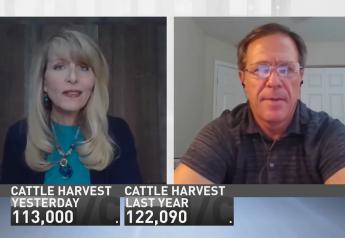Ferrie: Do you Roll the Dice Now and Plant Soybeans Early?

Farmers in western Illinois were in the field planting soybeans last week. Was that the right decision, given the good soil and weather conditions there, or a decision prone to crash and burn and cause replanting if a hard frost hits?
An important consideration is whether you have crop insurance now, says Ken Ferrie, Farm Journal Field Agronomist. Illinois farmers can purchase early replant insurance which enables them to have started planting on March 21.
“Insurance will pay them $75 if they have to replant, and the seed companies will give them full replant seed which lowers their financial risk considerably,” Ferrie says.
Weigh The Risks And Benefits
However, Farm Journal Test Plot research indicates agronomically there's no advantage most years in central Illinois to planting beans in March versus planting them between April 7 and April 15.
Where the benefit could come in is if those fields are rained out in the next week or two, preventing farmers from planting until after April 20.
“Once we dry out in late April after a rainy spell like that, everyone wants to shift to planting corn so we don't give up the yield in the corn crop,” Ferrie says. “So, in this scenario, having the soybeans planted earlier could have been a help.”
Hard Frosts And Replant Decisions
The risk of a hard freeze occurring in mid- to late April is always a possibility and a threat to early planted soybeans. Farmers are then faced with either putting up with less than ideal soybean stands or having to replant some fields.
“Last year the freeze on April 23 took out some of our beans planted before April 12,” Ferrie recalls. “Some fields, where the beans were all up, got totally smoked. It was kind of easy to manage those, we just replanted a number of the fields.”
The tougher call to make is in those fields where a lot of beans survive but stand counts are poor.
“The decision on what to do is easier if you have insurance, you can be quicker to pull the replant trigger,” Ferrie says.
Another consideration to leaving poor soybean stands in place is whether you’re prepared to battle weeds. You’ll likely have a weed management issue later in the summer, especially if you're in non-GMO soybeans. That’s what happened to some Illinois farmers last season.
“They ended up with some heavy weed pressure by the time we got to August,” Ferrie says.
Here are five additional questions to consider, if you plan to head to the field this week and plant soybeans:
1. Are you using seed treatments to protect the crop? Early soybeans tend to stay in the ground a long time, often up to 25 days, which makes them more vulnerable to disease pressure.
2. Are you a one planter operation? That will determine whether you have the capacity or equipment to plant soybeans and corn at the same time, if soil and weather conditions permit.
You want to be able to plant corn when conditions are right. Never delay corn planting. “Once conditions are ideal, you must plant corn,” Ferrie says. “If you miss the sweet spot, you could lose a ½ bu. to 1 bu. per acre for each day’s delay.”
3. Have you thought about soybean variety planting order? If you’re heading out to plant soybeans, Ferrie’s reminder is to go with your fullest season beans first and save shorter season beans for planting later.
“Based on our observations, we must plant full-season soybeans early enough to reach at least the three-trifoliate stage before the pre-solstice nights get too short,” Ferrie says. “There’s more time to get your short-season varieties planted early because they need fewer hours of darkness to trigger flowering.”
4. Is your landlord in the loop with regard to your planting intentions? It’s always good to keep them and other people on your farming team on the same page with your plans, so there are no or few surprises.
5. Are you prepared to give soybeans a helping hand? As soybeans try to emerge they may need some help if the surface crust is hard, meaning you might need to run a rotary hoe.
“We always say ‘hoe before you know,’” Ferrie says. “When you know you're already in trouble with the crust, and it's usually getting too late to get the full benefit out of a rotary hoe.
“Just remember, with these prices, you need to play every card you’ve got,” he adds.
Poor Saturated Cold Scores In Corn
About 30% of the seed samples Ferrie’s customers have sent in for evaluation are coming back with poor saturated cold scores. Along with that, farmers are telling him that some of their seed corn has been recalled by the company.
“Farmers are frustrated, especially if they can't get the same hybrid they started out with. But my advice is don't be upset with the seed company. They're doing their job and stopping you from planting poor seed that has drifted out of quality over time,” Ferrie says.
If you have seed corn that tests on the lower end of saturated cold score ranges, he says to plant that seed once conditions will enable the crop to emerge in five to six days.
“You guys putting starter in-furrow, keep in mind that severe pericarp damage scores tend to lead to more starter burn issues,” he adds. “When it comes to corn stands, many issues are solved when we plant based on soil conditions and not the calendar. This could be your highest yielding corn crop of your career. Let's not shoot ourselves in the foot before we start.”
Check out these additional articles on soybeans, and give Ferrie's complete Boots In The Field podcast a listen:
Prepare Now for a Successful 2024 Soybean Season
Are 100-Bushel Soybean Yield Averages On The Horizon?
Want to Take More Beans to the Bin at Harvest? Pay Attention to Soybean Growth Stages
Triple-Crop Soybean Success as Illinois Farmer Bucks Consensus
Shake the Disease? Plant Reduced Soybean Pops
8 Soybean Planting Reminders for When Mother Nature Doesn’t Cooperate







